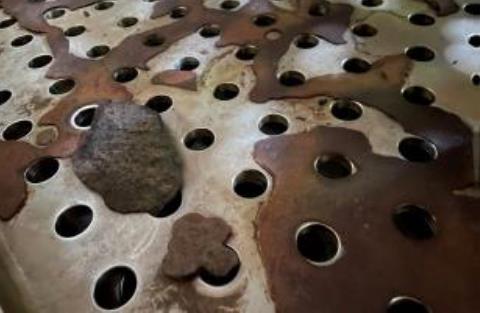

A rum distillery in the U.S. Virgin Islands uses a unique five-column distillation process to remove impurities and meet the highest rum quality and smoothness criteria
As part of wastewater treatment, the vinasse (distillation residue) is concentrated in a falling film evaporator (FFE) and sold as animal feed. The high concentration of organic and inorganic material in the vinasse, combined with the evaporation in the FFE, caused recurring fouling, limiting productivity and forcing frequent cleanings. For a number of years, the distillery used hydroblasting as the main method of removing deposits in the FFE (Figure 1), with an average cost of $200,000 per cleaning. Hydroblasting attempts were only partially successful and represented a high-risk task requiring confined space entry, working at heights, and the handling of high-pressure equipment.
The evaporator’s manufacturer had recommended a 2-step CIP (clean- in-place), but the procedure was unclear and non-standardized, so the benefits were inconsistent and hard to quantify. Additionally, a high amount of CIP residue was generated and had to be treated prior to disposal.
The distillery wanted to develop a standardized and efficient CIP procedure that would enable it to eliminate a high-risk activity and improve productivity and reliability.

Figure 1. Falling Film Evaporator (FFE) deposits were hard to remove and limited productivity
Our Veolia application experts supported the local team in conducting a process audit of the vinasse evaporators. Historically, a 2-step CIP cleaning procedure with soda ash followed by a citric acid solution was used. However, due to water scarcity and wastewater treatment constraints, the plant opted to simply perform hydroblasting on the vinasse evaporators. The original chemical cleaning procedure was unclear regarding concentrations, times and application methods, so the results were highly variable. The performance indicators and conditions indicating a cleaning was required were also undetermined, so CIP frequency was left to each operator’s decision.
Veolia’s audit included a review of the operating conditions and an analysis of historical operating trends. A detailed evaporator deposit analysis allowed our industry experts’ team to understand what contaminants were most susceptible to cause the fouling and how to prevent their accumulation. Key performance indicators were identified to highlight the proper frequency for applying CIPs.
Veolia offers an extensive portfolio of Food & Beverage anti-fouling and deposit control treatments under the FoodPro* product line. With experience that spans decades supporting the Food & Beverage industry, including the drinking alcohol, ethanol and biofuel segments, Veolia is uniquely equipped to analyze and understand producers’ processing challenges, and provide customized treatment and monitoring programs.
As the distillery’s deposit analysis showed that it was largely formed with organic contaminants (Figure 2), Veolia recommended a single-step CIP procedure using a FoodPro OLC blend containing a blend of alkali and dispersants specifically formulated for use in off-line cleaning.
结果
A CIP using the selected FoodPro OLC single-step cleaner was performed on the vinasse evaporator during the plant turnaround. The first cleaning resulted in improved performance of the vinasse evaporator as evidenced by a reduction in differential pressure (dP) across the unit and an extended operational run-length before another CIP was required. This indicates that the cleaning effectively removed fouling deposits that were restricting flow and impeding heat transfer efficiency.
To further improve the evaporator’s run-length and performance, Veolia recommended the use of a FoodPro anti-foulant additive to control inorganic deposit during operation. This FoodPro additive is approved as an additive for animal feed, so injecting it into the process stream was compliant with regulations. Moreover, the additive provided additional improvement to controlling the dP and extending run-lengths.
The single-step CIP procedure and the inorganic foulant control recommended by Veolia simplified and accelerated the cleaning process, extended the run-length and reduced downtime required for each cleaning. The plant has essentially discontinued hydroblasting cleanings, replacing this hazardous and costly procedure with safe, simple and efficient CIP cleanings. As a result of increased run-length and shorter downtime from the efficient cleanings and online antifoulant treatment, the distillery capacity increased from 10.5M PG (proof gallons) to 12M PG; an increase of ~14%, which value represented over $450,000 per year in productivity gain.
